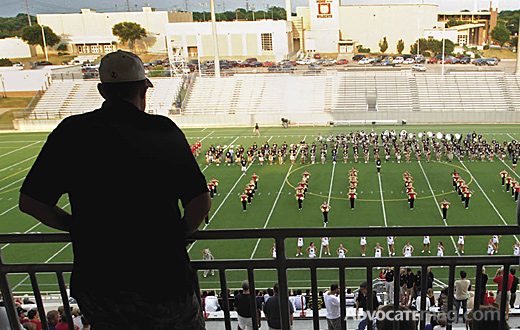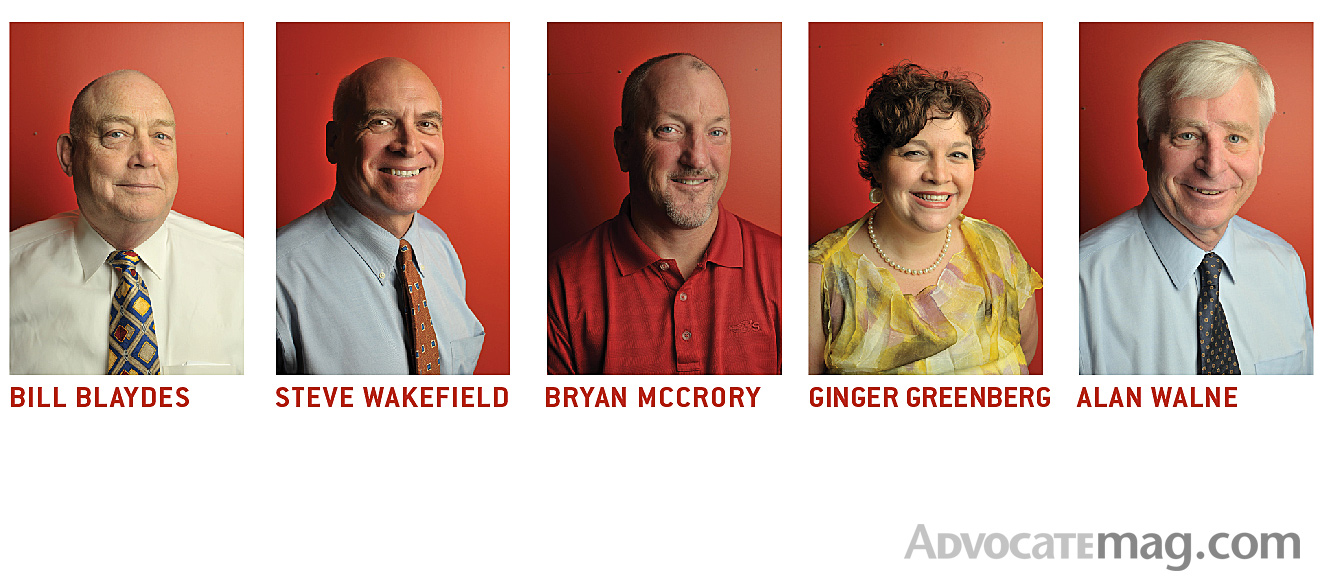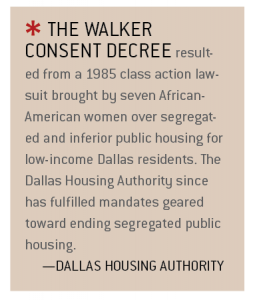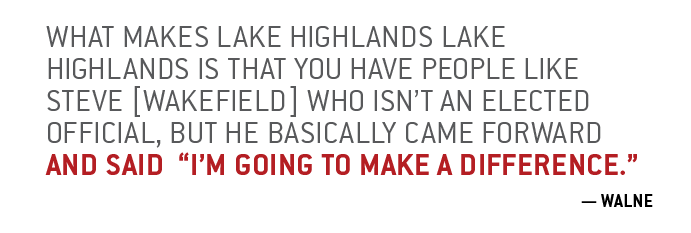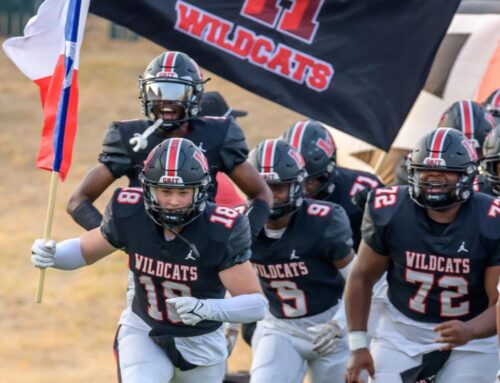Where is it? What is it? Why is it?
There are no official boundaries, but each of us knows what constitutes Lake Highlands. It’s the area served by Lake Highlands High School, right? But what about the small pockets that fall within the Berkner or Richardson high school attendance zones? How about the area known as Old Lake Highlands, or the neighborhood north of Shoreview, Lake Highlands on the map, that is served by the Dallas ISD?
The answers aren’t exactly simple, but exploring the question yields a wealth of interesting tidbits about our neighborhood, its character, its history and future.
On a sultry summer morning, several longtime neighborhood residents gathered at the Advocate offices to define Lake Highlands once and for all. After some coffee, Danish and scattered small talk about summer vacations, we got down to business. Listen to the full conversation, or read the story version of it below.
The guests
Bill Blaydes is a longtime Lake Highlands resident who has lived in his Dartridge home since 1978. His three children all graduated from Lake Highlands High School. He preceded Jerry Allen as the District 10 councilman.
Steve Wakefield is the former president of the Lake Highlands Area Improvement Association and has lived in Lake Highlands for 30 years. He lives in the Woodbridge neighborhood, north of LBJ, which is not part of the Lake Highlands High School attendance zone.
Bryan McCrory grew up in Oklahoma City and moved here in the ’80s. He has lived in Lake Highlands, east of Plano Road — the forgotten part of Lake Highlands, he jokes — for 25 years. He recently was elected president of the Exchange Club of Lake Highlands.
Ginger Greenberg’s Lake Highlands roots run deep. Her parents were Mr. and Miss Lake Highlands in 1970. After a brief time away, she moved her family — including a 6-month- and 3-year-old — to the Woodbridge neighborhood about three years ago. She is an attorney, a public relations account director, a member of Lake Highlands Junior Women’s League, Lake Highlands Area Early Childhood PTA and 2011-2012 Auction Chair for St. James Episcopal Montessori School. She says she aims to set up the next generation of Lake Highlands for success. She also has served on the Lake Highlands Area Historical Association.
Alan Walne just celebrated his 40th reunion from Lake Highlands High School (he and Greenberg’s parents were schoolmates) and has lived here since 1956, when his dad founded Herb’s Paint and Body at the corner of Northwest Highway and Easton. He grew up on the L Streets, which were brand new when he moved in. Walne’s parents moved into a home on Caribou Trail when he was in junior high; today he lives a few doors down from that house. He has served on the Dallas Park Board, City Council and now serves as the chairman of the Skillman Corridor TIF committee. His children graduated from LHHS, moved away, moved back and live in White Rock Hills.
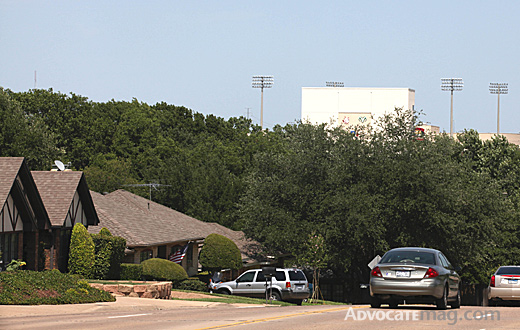
The Wildcat Stadium press box peeks out from behind the trees and rolling hills of Lake Highlands. PHOTO BY Benjamin Hager
District 10
Advocate editor: The Advocate website has a map of Lake Highlands, our delivery area of the Lake Highlands Advocate magazine, to be exact, but there are no official lines. What, physically, is Lake Highlands?
Greenberg: I think the easy answer is the Lake Highlands High School attendance area, but that’s too short and shallow to really correctly answer the question.
Advocate Editor: Because that doesn’t include the Woodbridge neighborhood, where you live …
Greenberg: Correct.
Walne: Ginger brings up an interesting point, because I agree that is the core, but Lake Highlands is a bigger area than that. You’ve actually got Shoreview, behind the police station, that is part of the DISD attendance zone. That goes back to the time, post-WWII, when the L Streets were being built, that there was an African-American shanty type town — it was called Little Egypt* — and when Richardson ISD and Dallas ISD were deciding attendance lines, RISD didn’t want that.
When we went through [city council] redistricting we tried to make sure all of Lake Highlands attendance zone was in District 10, so that the community would have that commonality.
Apartments
 Blaydes: Lake Highlands had about 28,000 apartment units when the Walker Consent Decree* forced affordable housing. [Apartment owners] were required to make 20-40 percent of their property affordable. With almost 30,000 apartment units in District 10, guess where everyone who needed affordable housing came? Families started moving into homes meant for only adults no playgrounds, no schools.
Blaydes: Lake Highlands had about 28,000 apartment units when the Walker Consent Decree* forced affordable housing. [Apartment owners] were required to make 20-40 percent of their property affordable. With almost 30,000 apartment units in District 10, guess where everyone who needed affordable housing came? Families started moving into homes meant for only adults no playgrounds, no schools.
Walne: The second tier to that is that there was a time (in the ’80s) when landlords could rent to adults only, and that was a popular thing for apartment owners to do in those days. Later the federal government said, “No. You can’t do that.” Then families began living in one- and two-bedroom apartments, in communities that were never intended for children. There were enough schools for homeowners’ kids, but then when kids started living in the apartments, there were not enough schools to accommodate them.
Advocate editor: While we are on the topic, do we consider the apartment complexes part of the Lake Highlands community?
Walne: Yes.
McCrory: Yes.
Blaydes: Absolutely.
Wakefield: I will say this, because I think we all agree: The attraction of Lake Highlands is the feel of community. Physically they are, no question, part of Lake Highlands, but the problem is turnover in tenants — they get this six-month deal and then move on — or in ownership, so I don’t know that people in the apartments necessarily feel that sense of community.
McCrory: I would completely agree. Being a part of YMCA athletics and band and athletics at the schools, I have experienced the struggle to get apartment community folks to participate, because of the challenges that many of them are facing. They don’t always stay, for one thing. They are a very mobile group. When you found someone who lived there who did feel the sense of community, you pulled them in. Perfect example is the Shorter family. John Shorter [a popular LHHS football player] graduated in 2008 with my son. His parents were very involved. But normally it is a problem getting [apartment renters] connected. Sometimes they work two jobs; they have single parents, sometimes no car. But the cool thing about it from my perspective is that our kids — that is, the homeowners’ kids — were exposed to a more diverse environment. We are no Southlake or Coppell. Lake Highlands has a richness and diversity because of the apartments.
Walne: Yeah, but you have two different issues. Are they a part of the community? Yes. But as to the issue of how engaged they are in community, I think there has been a strong effort by people like Steve [Wakefield], Bill [Blaydes], others such as [former councilman] Donna Halstead … creating groups, and after-school programs for the kids, to plug them in. The Audelia Creek Elementary principal has more than 90 percent apartment families, yet she has managed to get these parents engaged. Are they a part of the community? Yes. Are they as engaged [as homeowners]? No, but Bryan hit the nail on the head. They have a lot going on. I doubt there are a lot of stay-at-home moms in the apartments. They deal with issues some homeowners don’t. The reality is: They are paying taxes. They pay rent, [therefore] they pay taxes.
Editor: Forest-Audelia and Vickery Meadow, respectively in and near Lake Highlands, are known violent-crime hotspots. Does a feeling of inclusion or lack thereof relate to crime?
Walne: Steve, you’ve been in the hotbed of activity at Forest and Audelia …
Wakefield: I got involved because of frustration. I live near Forest and Audelia, and there was a point in time where there was open and obvious prostitution on the streets, gang bangers flashing signs, convenience stores blatantly selling drug paraphernalia … The city, especially with the economy going the way it was at the time, got behind on police and code inspectors. Apartment landlords become completely irresponsible … there were murders every month or so in some of the worst complexes. But in recent years, with [Police chiefs David] Kunkle and [David] Brown, we saw an increase in code inspectors. We had a community prosecutor who is gone now …
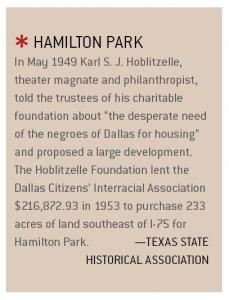 Editor: Will we get a replacement?
Editor: Will we get a replacement?
Walne: [District 10 Councilman Jerry] Allen is fighting to keep it in the budget.
Wakefield: But, you know, back to the question, when you are worried about being assaulted and your first issue is your personal safety or your kids’ safety, then it doesn’t give you a whole lot of time to become involved in the community.
Blaydes: Was it you or one of your neighbors who found the pickup in their driveway, walked up to the door, and found a prostitute doing her business?
Wakefield: Yes, but it has gotten better.
Greenberg: It has changed a lot; I wouldn’t have moved to the same neighborhood with a 2-year-old if it hadn’t.
Walne: What makes Lake Highlands Lake Highlands is that you have people like Steve [Wakefield] who isn’t an elected official, but he basically came forward and said “I’m going to make a difference,” and spent countless hours attacking this problem, getting on a first-name basis with the police so when you did have additional dollars in the budget, this was an area understood to deserve attention. It’s not necessarily a councilman doing the work. It took a yeoman’s effort to make these changes begin to happen. And that’s the thing when you start trying to define boundaries. Technically speaking, someone may say Steve’s in Woodbridge. From my point of view on the council and so forth that is very much a part of Lake Highlands … and this man is obviously invested in the Lake Highlands community.
Schools
Editor: How far does District 10 reach?
Blaydes: Northern to Buckingham and to the Garland city limits on the east.
Greenberg: It includes Liberty Junior High and north to Berkner.
Blaydes: And White Rock Creek is our western boundary.
McCrory: Sheffie Kadane [District 9] has the area north of that and part of my neighborhood, Highland Meadow, east of Plano, which is partly served by DISD. The part that is served by RISD is District 10 and the DISD part is District 9.
Editor: What about Old Lake Highlands and the Peninsula neighborhood [south of Northwest Highway and east of White Rock Lake]. Do we consider them part of Lake Highlands?
Walne: More importantly, I don’t think they consider themselves a part of Lake Highlands.
[Laughter]McCrory: Mainly they don’t associate with Lake Highlands because of the different school districts. My neighborhood is split between Wallace, part of RISD, and a DISD school.
Greenberg: Hamilton Park* is also split — three ways —Richardson, Berkner and Lake Highlands.
Walne: I was in high school at Lake Highlands when they shut down Hamilton Park High School, a desegregation effort. The Hamilton Park subdivision was designed in 1974 as a black neighborhood. In my opinion, when they split them up, it was one of the worst things that could happen to them. LHHS
had some minority students, but Hamilton Park was designed as a black community with an elementary, junior high and high school. The buses drove up and started taking them off to Lake Highlands High School — they said “we’re going to split you all up” — which is unfortunate because, you talk about a sense of community, they had it. Hamilton Park is very much a part of Lake Highlands and needs to be treated as such and be included in everything that is going on. At the same time, they are very much their own community.
Blaydes: Families, professionals, moved into Hamilton Park, raised their families and when the children grew up, they moved away from Hamilton Park to other parts of Dallas in many cases. But today you have a neighborhood in which the seniors are dying, the children are spread out and now the majority of Hamilton Park is for lease …
Walne: … and they are dealing with similar problems to the apartment-related problems in other parts of Lake Highlands.
Blaydes: That community center over there, the park, is a true jewel. It is the pride of that section of Lake Highlands … it is very much a part of the fabric of Lake Highlands.
Origins
Editor: When did Lake Highlands become Lake Highlands?
Blaydes: What you saw was that Lake Highlands may have been part of the City of Dallas, but it was part of the Richardson school system, so the city kind of pulled away because the school district was strong, and Richardson kind of ignored us because we were part of Dallas, and so we became the red-headed stepchild of both …
As to the name, there was a time when White Rock Lake came almost all the way up to Flag Pole Hill — it was then literally lake highlands.
Editor: And some of the individual neighborhoods have Lake Highlands in the name and some don’t …
Walne: I can tell you about the name of the L Streets — the builder, Charles C. Ladenberger, who still lives around here, didn’t want a street named after him, so the designers just had every street begin with L instead.
McCrory: Well, when did they decide to name the high school Lake Highlands?
Walne: The interesting story about the high school is that the PTA president, Jean Evans, and her husband, former Dallas mayor Jack Evans, had a ranch on Audelia — horses and all. Jean had gone to Woodrow, as my parents had, and when they had the meeting to determine what Lake Highlands’ colors and mascot would be, Jean said, “Well, I’ve always been a Wildcat, and we’re going to be Wildcats, and we’ll be red and white.” Jean said that’s the way it’s going to be, (chuckle) and that’s the way it was.
Editor: Was the neighborhood named after the high school, then?
Greenberg: No, the elementary had been there; Lake Highlands was Lake Highlands long before.
Walne: And back then, like now, RISD had a better reputation than DISD, and you found people, like my parents, wanting to move up here.
Blaydes: In the very early ’90s, there was an upheaval here in our part to pull out of RISD and become Lake Highlands, Texas.
Editor: You were going to secede?
Blaydes: There was a move for secession.
Editor: How close did we get to that?
Walne: Not very close (laughter)
Blaydes: Not real close, but we had the right size, industrial mix — Texas Instruments was in District 10 at that time — and we had the population. We found we would not be able to sustain an educational system, police force and fire stations. But we went all the way to Austin. We had guys that were attorneys who volunteered their time …
Walne: Be careful with that “we”.
(Laughter)
Blaydes: I was part of that movement, not you, yes.
Walne: There was some serious discussion from a school district perspective. Lake Highlands’ ninth-grade center came out of this process. We were going to have to build a new junior high … but the freshman center was constructed instead. Once we did it, everyone wanted to build a ninth-grade center. Richardson High School built a ninth-grade center because Lake Highlands had one. Everything had to be equal, so Lake Highlands wasn’t getting more than the other RISD schools.
McCrory: I do understand RISD’s perspective of treating all of the high schools equally. I get that. Everyone wants quality facilities for your kids. We’ve lobbied for a pool at Lake Highlands High School …
Blaydes: There was a bond package in the ’80s that would have built a nanatorium at LHHS …
Walne: OK, here we go.
Blaydes: …but it wasn’t approved because Richardson would not allow Lake Highlands to have the football stadium and the pool, pure and simple.
Future
Walne: You can look at Lake Highlands and say, where are we going? The success story to be told is the youth movement.
Blaydes: They are coming home.
Greenberg: Our friends … and people who haven’t lived here before are moving here, too.
Walne: Not solely our kids moving back, but I also hear Downtown folk, law firms and so forth, when they have new people coming in, they recommend our neighborhood. Lake Highlands is affordable. The routes to Downtown are easy and diverse. You can put your kids in the public schools. Reality is that even though we thought the school attendance would dwindle after the closing a few years ago of thousands of apartment units, RISD this year had more students in every elementary school than the year before. These are neighborhood kids that have moved back home with young children. That is why you have a clamoring now for more — shopping, restaurants …
McCrory: We have built a community on the foundation your parents built. I came here for the school district, but on top of that is this incredible community culture — people get engaged. Not just individuals but strong groups. Women’s League, Exchange Club, homeowners’ associations — they create the success story that is bringing people into the neighborhood.
Greenberg: I am part of that generation that moved back. My grandparents and parents live here, and my sister just bought a house in the area. What we are looking for is the quality public schools and the rich diversity and for our children to grow up in the neighborhood that feels like home — like a small town. That is what I came back to after leaving for the University of Missouri. That is why I didn’t stay in Kansas City or St. Louis but came back. Now what we need, this era, is retail and restaurants. We had a free afternoon and went to Rusty Taco, on Greenville. We would have spent our dollars in Lake Highlands had there been something similar.
McCrory: From a retail perspective, because I work for Brinker [International, owner of Chili’s and Maggiano’s], I can say some of the difficulties. We — and that is us, including me — want to reach for the stars, but we also need to nurture the places we have — Highlands Café, for example. Our challenge as a community is to put our words to action and support the businesses we do have — Atomic Pie, Picasso’s, Mi Cocina … and give credit to these guys at Mi Cocina. They stuck it out, and they made it work. And Picasso’s was basically created here in Lake Highlands.
Conclusion
Editor: So everyone agrees, Lake Highlands is the Lake Highlands High School attendance area, with many exceptions?
Wakefield: I don’t think everyone will agree on anything, but that might be about as close as we’ll get.

